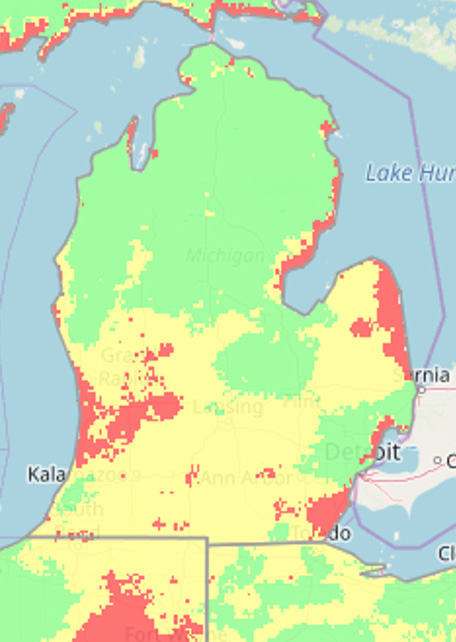Using fungicides to suppress Fusarium head scab in wheat
Wheat fields are beginning to show signs of head emergence. This marks the time to consider applying fungicides to reduce the risk of head scab and leaf diseases.

The wet weather this spring has greatly elevated the risk of Fusarium head scab. At this point, the use of a fungicide at flowering is the best response for trying to curb the disease and suppress its associated mycotoxin (a.k.a. DON or vomitoxin). A fungicide application at the flowering stage offers the added benefit of helping keep leaf diseases in check.
Head scab is favored by moderate temperatures (56 to 86 degrees Fahrenheit) and high relative humidity (particularly in excess of 90%) around and during the flowering stage. Michigan State University Extension recommends utilizing the Fusarium head scab risk assessment tool. This prediction model provides a daily level of risks for specific locales. For southern Michigan where wheat is heading, the model is suggesting some of the highest risks levels that we have seen in recent years. For those in central Michigan where the flowering stage may still be a week away, the level of risk may be significantly less or even low depending on weather. The model is correct most of the time, but growers are also encouraged to rely on their knowledge of localized environments and their own experience.
Another important consideration is the innate resistance level individual varieties possess to fend off the disease. Below is a table providing a list of some common, established varieties and their respective resistance rating. Another good source of information is the Michigan State Wheat Performance Report. Table 3 of this updated report provides the resistance ratings for varieties from the 2018 season.
|
Relative susceptibility of winter wheat varieties to Fusarium head scab |
|||||||
|---|---|---|---|---|---|---|---|
|
Soft white winter wheat |
Soft red winter wheat |
||||||
|
variety |
rank* |
variety |
rank* |
variety |
rank* |
variety |
rank* |
|
Ambassador |
VS |
Pioneer 25R40 |
S |
Branson |
MS |
MCIA Roane |
MS |
|
Skeet Safety |
VS |
Wellman 206 |
S |
Red Devil |
MS |
Pioneer 25R50 |
MS |
|
Jupiter |
S |
Hopewell |
S |
AgriMax 413 |
MS |
Red Dragon |
MR |
|
AC Mountain |
S |
Shirley |
S |
DynaGro 9223 |
MS |
DF 112R |
MR |
|
Aubrey |
S |
DynaGro 9243 |
S |
Pioneer 25R39 |
MS |
Pioneer 25R25 |
MR |
|
Pioneer 25W36 |
S |
Pioneer 25R47 |
S |
DF 105R |
MS |
Agrimax 415 |
MR |
|
E6012 |
S |
Red Ruby |
S |
Sienna |
MS |
Steyer Hunker |
MR |
|
Venus |
S |
Pioneer 25R62 |
S |
Rupp 907 |
MS |
L334 |
MR |
|
DynaGro 9242W |
MS |
Whale |
S |
Sunburst |
MS |
Rupp 972 |
MR |
|
Pioneer 25W43 |
MS |
DF 109R |
S |
DynaGro 9171 |
MS |
||
|
Syngenta 901 |
MS |
Agrimax 438 |
S |
AgriMax 444 |
MS |
||
|
Pioneer 25W31 |
MS |
DF 045 |
S |
DynaGro 9053 |
MS |
||
|
DynaGro 9353W |
MS |
SC1342 |
S |
DynaGro 9042 |
MS |
||
|
|
|
DynaGro 9522 |
S |
Wellman 123 |
MS |
|
|
|
* the relative susceptibility of varieties are ranked as VS (very susceptible), S (Susceptible), MS (moderately susceptible), or MR ( moderately resistant) |
|||||||

Ground application is generally recommended for applying wheat fungicides. However, aerial application of fungicides may be necessary where wet conditions prohibit ground rigs from operating. Fungicides applied by air may have reduced head deposition compared to ground rigs, but they still can offer significant protection against head and leaf diseases. See Aerial Application of Fungicides from work in North Dakota for application recommendations.
The best fungicides for head scab include Prosaro, Caramba and Miravis Ace. These products usually reduce the severity of the disease and the associated mycotoxin (D.O.N. or vomitoxin) level by half if applied correctly. To optimize the benefit of these fungicides, growers should treat 2 to 7 days after the heads have begun to flower. An information piece, Managing Fusarium head blight, is available as a resource.



 Print
Print Email
Email